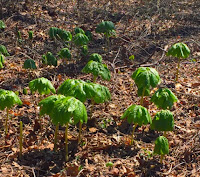 |
| Mayapples along Templeton Way |
Yesterday, following Sunday Eucharist at the Chapel of St.
Mary’s, we rode past a patch of plants with peculiar green leaves, and I
asked resident botanist, Dr. Victoria Sullivan, to turn around and make an
identification of the patch for me. At first, I thought we had come upon a
group of plants unlikely to be growing on the Mountain – pitcher plants
prevalent in south Louisiana bogs. However, when we retraced our steps and
examined the colony of green plants with their umbrella-like leaves, Dr.
Sullivan identified them as a colony of Mayapple, minus the flowers that appear in early May. The umbrella-like leaves protect large white flowers that bloom
this month and in May.
Mayapples were once called “witches umbrellas,” and some
believed that the plants were poisonous, apart from the ripe fruit that can be
used as a cathartic and purgative. Actually, the fully-ripe fruit, which turns
yellow in late summer and is often called wild lemon, can be made into jams and
jellies, even pies. But rinds and seeds are poisonous.
When I first glimpsed the colony of Mayapple, I thought
immediately of my mother who believed in fantastical beings – mystical-like gnomes,
elves, and other wee folk she painted into oil renderings and who could have taken
shelter under the umbrella-like Mayapples. She would have believed the stories
about the English version of this plant, the Mandrake, one of which reports
that the mandrakes are alive and scream when pulled from the ground. Their
screams were reputed to drive people insane. Mother believed in magical beings,
but she shied away from stories about dragons and mermaids, thinking that the
dragon with its fish scales, giant horns, and alligator tail might frighten us.
Instead, she chose to read aloud to us each night chapters from Peter Pan, Cinderella, Alice in Wonderland,
and a story that ultimately did frighten me – that of Snow White – and was the Mayapple the apple she consumed that caused her to fall into a
sleep from which no one except a prince could rouse her?
Mother Dorothy wasn’t too far off base in her perceptions
about magical creatures. After Dr. Sullivan had identified the Mayapple, I
found a poem entitled “Mandrakes” by Minnie Wait that could have been written
by my mother:
“Down in the shady woodland
Where fern fronds are uncurled
A host of green umbrellas
Are swiftly now unfurled.
Do they shelter fair people
From sudden pelting showers
Or are the leaves but sunshades
To shield the waxen flowers?”
Scientists are now studying and deriving anti-tumor drugs
from the toxic tubers of the Mayapple. American Indians often boiled the roots from
this plant and used the water to cure tummy aches. Also, the Podophyllum peltatum can be applied topically to warts. I wonder if the south
Louisiana traiteurs have used it as a
remedy to cure warts – a healing for which they are famous.
Whatever the uses of this magical-looking plant, my sighting
provided fodder for a blog about a field of bumbershoots along the path to St.
Mary’s on a sunny Sunday morning and inspired photography by Dr. Sullivan.













No comments:
Post a Comment